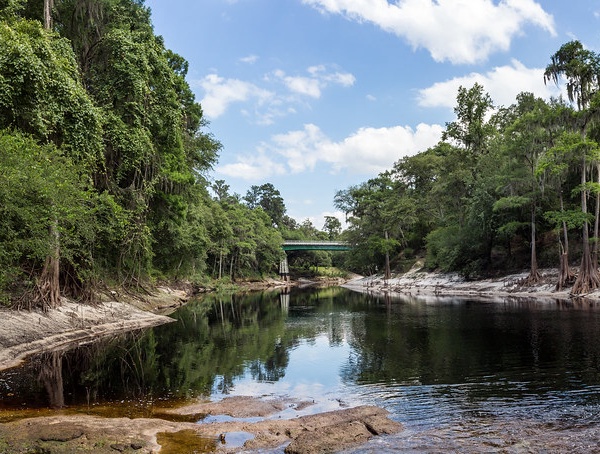Most of the time, the Floridan Aquifer feeds the nearly 200 springs in the Suwanee River Basin, pushing water up through ancient porous limestone to the surface.
During times of flood, pressure from the rising waters can cause the springs to reverse flow. The springs recharge the aquifer instead of the other way around. This reversal historically kept the region’s iconic freshwaters healthy and thriving.
The relationship between the waters underground and those at the surface is not one-way. It’s give-and-take.
That natural reciprocity helped Florida’s rivers and world-class springs run clear, tinted with undulating shades of aquamarine. Some were more tannic with transparent golden tones, and others jeweled blues. Verdant eelgrass rose from sandy white riverbeds and swayed with the current. Moss-hung oaks and cypress reflected back the canopy overhead.
But today, rather than kaleidoscopic greens and blues, many rivers and springs in the Suwannee Basin, like others around the state, flow with inky green slime, pallid eel grass and murky waters that conceal many of the springs’ white sand bottoms. The change comes down to people, essentially, too much polluting and too much groundwater pumping.
The human relationship with the river is not give-and-take. It’s been mostly one-way.
Along the Santa Fe River, part of the Suwannee Basin, permitted activities from water-bottling plants to the nitrate pollution that flows from development and agriculture underscore the concept, fundamental to Florida water law, that water resources are valued for their highest and best use by humans.
But here and around the world, a growing legal movement is challenging that framework. The so-called Rights of Nature movement asks: Should we view ecosystems not as property but as entities with the legal right to exist and flourish? Should rivers, mountains, forests and glaciers be considered legal persons, in the same way that corporations have won many of the rights assigned to people? Governments from Toledo, Ohio, to South America and beyond have said yes, granting such rights to rivers, lakes, animals and even a wild rice sacred to America’sOjibwe people.
“It’s time for deep, systematic change,” says John Moran, a Gainesville-based nature photographer whose camera has captured the profound changes underway in the Suwannee Basin between the 1970s and now. The pollution befouling Florida’s waters, Moran says, “by and large, is not illegal.”
Read the full article by Alexandra Sabo from April 22, 2020 in WUFT news here.

